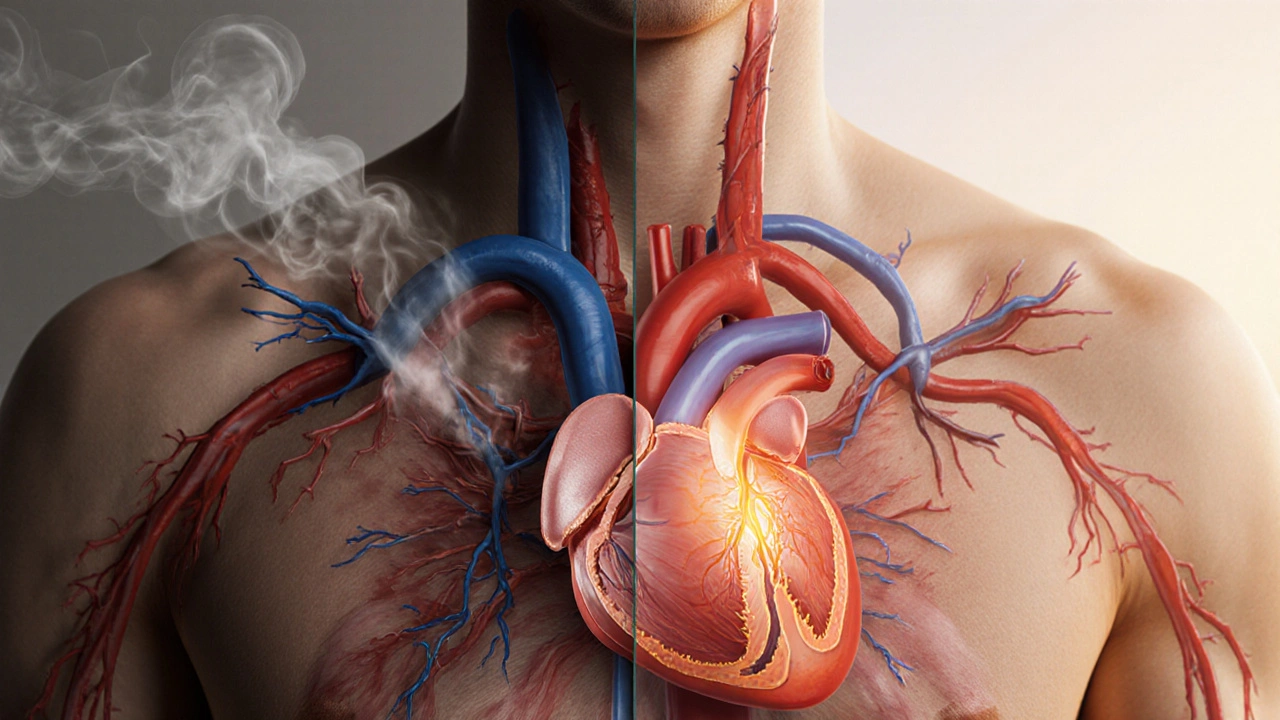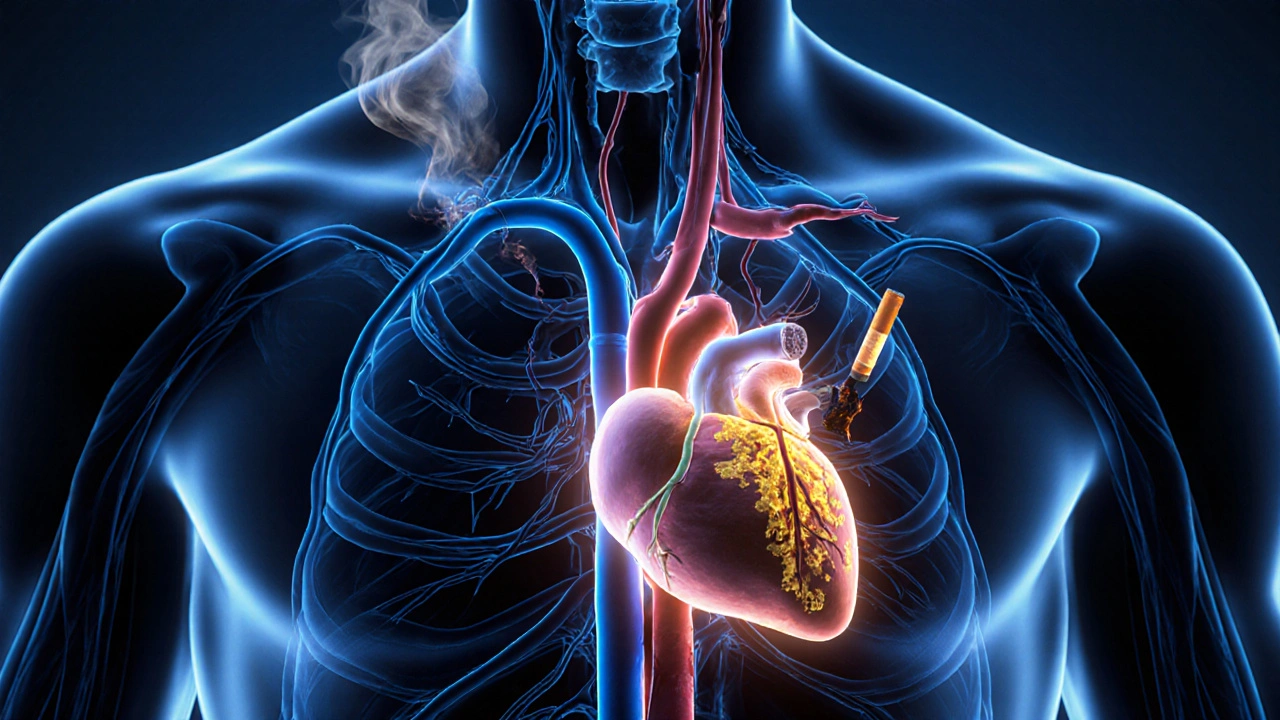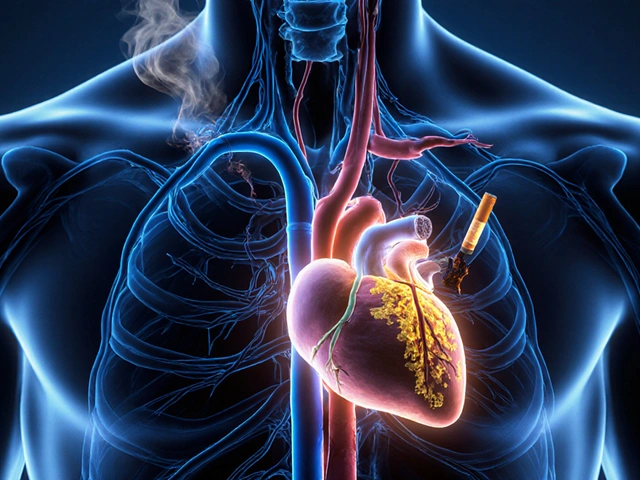Coronary Artery Disease Risk Calculator
Risk Level
Recovery Timeline
Key Recommendations
- Consider nicotine replacement therapy
- Schedule a cardiovascular check-up
- Start physical activity program
20 Minutes
12 Hours
2-12 Weeks
1 Year
When you light up a cigarette, you’re not just harming your lungs - you’re also putting the arteries that feed your heart at serious risk. Understanding how Coronary Artery Disease is a condition where plaque builds up in the arteries supplying the heart muscle, leading to reduced blood flow and potential heart attacks is the first step toward making the decision to quit.
Key Takeaways
- Smoking doubles the risk of developing coronary artery disease (CAD) compared to non‑smokers.
- Within one year of quitting, the risk of a heart attack drops by 50%.
- Even low‑level smoking (a few cigarettes a day) raises CAD risk.
- Effective quitting methods include nicotine replacement therapy, prescription meds, and counseling.
- Regular check‑ups can track the heart’s recovery after you stop smoking.
How Smoking Fuels Coronary Artery Disease
To see why cigarettes are so damaging, think of the coronary arteries as highways delivering oxygen‑rich blood to the heart. Smoking introduces several toxic agents that sabotage these highways:
- Nicotine stimulates the release of adrenaline, causing blood vessels to constrict, which spikes blood pressure and makes the heart work harder.
- Carbon monoxide binds to hemoglobin faster than oxygen, reducing the amount of oxygen that reaches heart tissue.
- Tar and other chemicals increase platelet aggregation the clumping together of blood cells that can trigger clots, raising the chance of a blockage.
- Free radicals from smoke damage the lining of the arteries, prompting atherosclerosis the buildup of fatty plaque inside artery walls.
- Smoking lowers the production of nitric oxide, a molecule that normally keeps vessels relaxed and prevents plaque formation.
All these mechanisms compound, turning a healthy artery into a narrowed, hardened tube - the hallmark of CAD.

Current Statistics (2024)
Data from the British Heart Foundation and the Global Burden of Disease Study show a clear picture:
| Smoking Status | Relative Risk of CAD | Annual Heart‑Attack Rate (per 1,000) |
|---|---|---|
| Never Smoked | 1.0 (baseline) | 2.1 |
| Former Smoker (quit ≥5yrs) | 1.3 | 2.8 |
| Current Light Smoker (≤5 cig/day) | 1.6 | 3.5 |
| Current Heavy Smoker (≥20 cig/day) | 2.2 | 5.9 |
Even “light” smokers face a 60% higher risk of CAD compared with never smokers. The numbers climb sharply with more cigarettes per day.
What Happens When You Quit
The good news is that the body begins to heal quickly once you stop smoking:
- 20minutes: Heart rate and blood pressure drop to normal levels.
- 12hours: Carbon monoxide levels fall, allowing oxygen‑carrying capacity to improve.
- 2-12weeks: Circulation improves and lung function rises by up to 30%.
- 1year: Risk of coronary heart disease is about half that of a continuing smoker.
- 5years: Stroke risk drops to that of a non‑smoker.
- 10years: Risk of lung cancer aligns with never‑smokers, and CAD risk nearly matches baseline.
During this timeline, medications like statins cholesterol‑lowering drugs that also stabilize plaque can further protect the heart, especially for those with existing CAD.
Practical Steps to Quit Smoking
Quitting isn’t just about willpower; it’s about planning and support. Here’s a straightforward road map:
- Set a quit date: Choose a day within the next two weeks and mark it on your calendar.
- Identify triggers: Write down when and why you reach for a cigarette (stress, coffee, after meals).
- Choose a quitting aid:
- Nicotine Replacement Therapy (NRT) - patches, gum, lozenges.
- Prescription meds - varenicline (Champix) or bupropion (Zyban).
- Behavioral counseling - face‑to‑face, phone helplines, or online apps.
- Build a support network: Tell family, friends, or join a local quit‑smoking group. Their encouragement can be a game‑changer.
- Replace the habit: Keep your hands busy with stress balls, chew sugar‑free gum, or take short walks.
- Monitor progress: Use a quit‑tracker app to log cravings, celebrate smoke‑free days, and watch your heart‑health metrics improve.
- Seek professional help if needed: Your GP can assess cardiovascular risk, prescribe meds, and refer you to a smoking cessation specialist.

Managing Cravings and Relapse Prevention
Cravings usually peak within the first three days and then taper off. Strategies to survive them include:
- Deep‑breathing exercises - inhale for 4 seconds, hold 4, exhale 4.
- Drink water - it dilutes nicotine residues and distracts the mind.
- Physical activity - a 10‑minute brisk walk can lower the urge by up to 40%.
- Avoid alcohol and heavy meals for the first month - they often trigger smoking urges.
If you slip, treat it as data, not defeat. Note what caused the lapse, adjust your plan, and get back on track within 24hours. The average smoker attempts quitting 7-8 times before success; persistence matters more than perfection.
When to Talk to a Doctor
Even if you feel fine, a quick cardiovascular check‑up can reveal hidden damage. Schedule an appointment if you:
- Experience chest pain, shortness of breath, or unusual fatigue.
- Have a family history of early‑onset heart disease.
- Notice persistent coughing or wheezing after quitting.
- Are over 40 and have smoked more than 10 pack‑years.
Your doctor may order an ECG, a lipid panel, or a coronary calcium scan to gauge plaque buildup. Early detection combined with quitting dramatically improves long‑term outcomes.
Frequently Asked Questions
How quickly does heart health improve after I stop smoking?
Within 20minutes your heart rate and blood pressure normalize. Within a year the risk of coronary heart disease drops by about 50%, and after five years your risk aligns closely with that of a lifelong non‑smoker.
Do e‑cigarettes reduce the risk of CAD?
Current research shows that while e‑cigarettes contain fewer toxic chemicals than regular cigarettes, they still deliver nicotine and oxidative agents that can promote atherosclerosis. They are not a proven safe alternative for heart health.
Can nicotine replacement therapy worsen CAD?
NRT provides nicotine without the harmful combustion products of tobacco. Studies indicate NRT does not increase CAD risk and may even reduce it by helping smokers quit faster.
What role do statins play after quitting smoking?
Statins lower LDL cholesterol and stabilize existing plaques, which is especially valuable for recent quitters whose arteries may still be inflamed. Your doctor can assess whether a statin is right for you.
Is it ever too late to quit and benefit my heart?
No. Even long‑term smokers see measurable risk reductions after quitting. The older you are, the greater the absolute benefit because you avoid future heart events.
Quitting smoking isn’t just a lifestyle tweak; it’s a direct prescription for a healthier heart. By understanding the mechanisms, tracking the timeline of recovery, and using proven quitting tools, you can dramatically cut the chance of coronary artery disease and live longer, more active years. Take the first step today - your heart will thank you.



Joe Evans
October 7, 2025 AT 17:34Hey folks! 🌟 Quitting smoking is one of the best gifts you can give your heart, and the science is crystal clear – fewer plaques, lower pressure, brighter future! 🎉 It’s amazing how quickly the body starts to heal, from 20 minutes to a full year, and every day without a cigarette adds up like building blocks for a healthier life!!! Keep the momentum going, and remember you’re not alone on this journey!!!
Colin Boyd
October 13, 2025 AT 04:28While the data presented appears comprehensive it neglects the nuanced interplay of socioeconomic determinants that influence smoking prevalence and cessation success rates.
John Petter
October 18, 2025 AT 15:23One must appreciate the elegance of physiological restoration post‑cessation; the body exhibits remarkable resilience. The reduction in arterial inflammation is evident within weeks, and platelet aggregation normalizes swiftly. Such facts underscore the value of quitting.
Annie Tian
October 24, 2025 AT 02:17Congratulations to anyone taking steps toward a smoke‑free life! The timeline you outlined is both realistic and inspiring; each milestone reflects a tangible improvement in cardiovascular function. Your dedication will pay off in fewer doctor visits, better stamina, and a brighter future for your loved ones.
April Knof
October 29, 2025 AT 13:12From a cultural standpoint, many societies have historically woven tobacco into rituals, yet modern public health initiatives are reshaping those narratives. Understanding the heritage behind smoking can help tailor cessation programs that respect tradition while promoting heart health. It’s a delicate balance worth pursuing.
Tina Johnson
November 4, 2025 AT 00:06The article omits discussion of nicotine’s effect on endothelial nitric oxide synthase, a critical oversight; without nitric oxide the vasculature remains constricted, exacerbating atherosclerotic risk. Moreover, the brief mention of statins lacks depth regarding their plaque‑stabilizing properties post‑cessation. Such gaps diminish the overall utility of the piece.
Sharon Cohen
November 9, 2025 AT 11:01It feels as though the narrative glorifies quitting as a panacea, overlooking the psychological toll and relapse cycles many endure.
Rebecca Mikell
November 14, 2025 AT 21:56I appreciate the thorough breakdown; the step‑by‑step guide aligns well with what many of us have found effective. Sharing personal strategies, like swapping cigarettes for a short walk, can further enrich the discussion and empower newcomers.
Ellie Hartman
November 20, 2025 AT 08:50Quitting smoking is truly a multidisciplinary triumph; it touches physiology, psychology, and community support all at once.
First, the immediate physiological changes-within twenty minutes, heart rate normalizes, and blood pressure drops, setting the stage for longer‑term recovery.
Second, the carbon monoxide levels in the bloodstream fall dramatically after twelve hours, allowing oxygen transport to improve dramatically.
Third, the reduction in platelet aggregation over the next weeks means fewer clots and a lower chance of acute coronary events.
Fourth, the reversal of endothelial dysfunction begins, restoring nitric oxide production and improving arterial elasticity.
Fifth, regular aerobic activity amplifies these benefits, as exercise promotes HDL cholesterol and further stabilizes plaque.
Sixth, the psychological aspect cannot be understated; forming new habits, such as chewing gum or mindful breathing, replaces the ritual of smoking.
Seventh, support networks-family, friends, or online groups-provide accountability and emotional reinforcement.
Eighth, pharmacologic aids like nicotine replacement therapy or varenicline bridge the gap, reducing withdrawal severity.
Ninth, routine medical check‑ups allow clinicians to monitor lipid panels, blood pressure, and any residual inflammation.
Tenth, statins may be introduced for those with existing cardiovascular risk, further decreasing plaque progression.
Eleventh, the long‑term data show that after five years, stroke risk aligns with that of lifelong non‑smokers, underscoring the lasting impact of cessation.
Twelfth, even after a decade, former smokers retain much of the cardiovascular benefit, illustrating that it’s never too late to quit.
Thirteenth, the societal impact includes reduced healthcare costs and fewer second‑hand smoke exposures for loved ones.
Fourteenth, education campaigns that highlight these timelines empower individuals to make informed choices.
Fifteenth, the cumulative effect of all these factors creates a virtuous cycle, encouraging continued healthy behaviors.
In summary, each step toward a smoke‑free life is a concrete investment in one’s heart, mind, and community.
Alyssa Griffiths
November 25, 2025 AT 19:45One must not overlook the fact that the tobacco industry has historically funded research designed to downplay cardiovascular risks, a fact that still colors certain data sets; the manipulation of epidemiological studies is well‑documented, and the lingering influence can be seen in the way some reports still minimize the role of nicotine in endothelial dysfunction!!!
Jason Divinity
December 1, 2025 AT 06:39The presented statistics are consistent with the latest meta‑analyses, yet it would be beneficial to incorporate discussion of genetic polymorphisms affecting nicotine metabolism, as they modulate individual responses to cessation therapies. Additionally, a brief note on the comparative effectiveness of combination NRT versus varenicline would enhance clinical applicability. Overall, the article is solid, but a few nuanced additions could elevate it further.
andrew parsons
December 6, 2025 AT 17:34Clearly, the moral imperative to quit smoking aligns with public health ethics, and any deviation from this stance is simply unacceptable. 😊